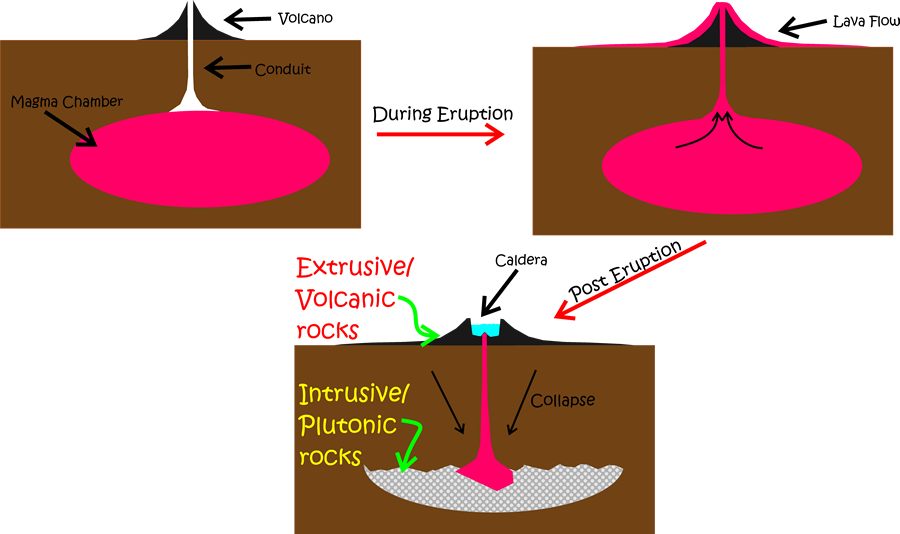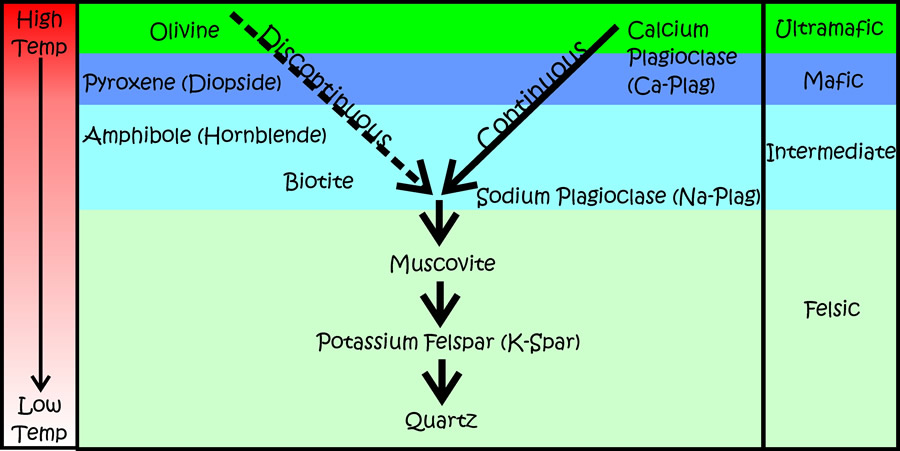-Stage 1.4-
Igneous Rocks
 Definition - Igneous rocks form from the solidification of molten rock (AKA lava or magma)
Definition - Igneous rocks form from the solidification of molten rock (AKA lava or magma)
Lava - molten rock above the ground surface
Magma - molten rock below the ground surface
Igneous Rocks
-
There are 2 types of Igneous Rocks
-
Intrusive - (Plutonic) Rocks formed from molten rock Inside the Earth's crust. They cooled slowly, allowing the crystals in the rock to form larger. The slower the rock cools the larger the crystals.
-
Extrusive - (Volcanic) Rocks formed from molten rock on the External surface of the Earth. They cooled quickly, preventing larger crystals from forming. The faster it cools the smaller the crystals.
-



Understanding Bowen's Reaction Series
-
Minerals at the top crystallize first as the magma cools
-
These minerals then fall to the bottom of the magma chamber
-
The remaining magma is then more rich in lower temperature minerals (i.e. magma that will stay liquid for longer)
-
Minerals on the bottom crystallize last within the spaces left between already crystallized minerals
-
This generally applies to Intrusive Igneous Rocks only because Extrusive Igneous Rocks cool too quickly
-
Discontinuous - Means that when the temperature of the magma cools enough the cooler temp mineral starts to form
-
Continuous - Means that the minerals that form have a variety of chemical combinations that form depending on the temperature all with similar chemical properties (i.e. all are plagioclase but they mainly range from dark (Ca) to light (Na))
-
Definitions Used for Identification
(Click on the images for a larger image)
Textures
Visible Crystals:
Pegmatitic - This is when the crystals in the rock are larger than 1 cm across. This is the most common type of rock where gem stones are found due to the large crystal size.
Non-Visible Crystals:
Porphyritic - This is when the background are not visible but there are large crystals "floating" in the mass
Vesicular - This is when the rock contains lots of air holes, causing the rock to be lighter then usual
Pyroclastic - This is when the rock forms from angular pieces of other rocks in a aphanitic matrix (similar to porphyritic but larger/angular crystals/ rock chunks)
Compositions
Felsic - "light" rocks, contain light colored minerals (Also low temp minerals See Bowen's Reaction Series above) (quartz, Potassium feldspar, micas)
Intermediate - A mixture of felsic and mafic, "salt and pepper" "light and dark" (Potassium feldspar, Sodium Plagioclase, Biotite, Amphibole)
Mafic - "dark" rocks, contain dark colored minerals (Also high temp minerals See Bowen's Reaction Series above) (Pyroxene, Amphibole, Calcium Plagioclase)
